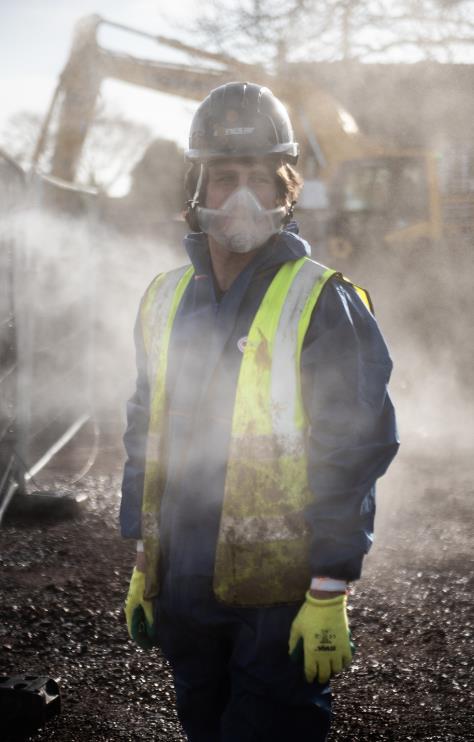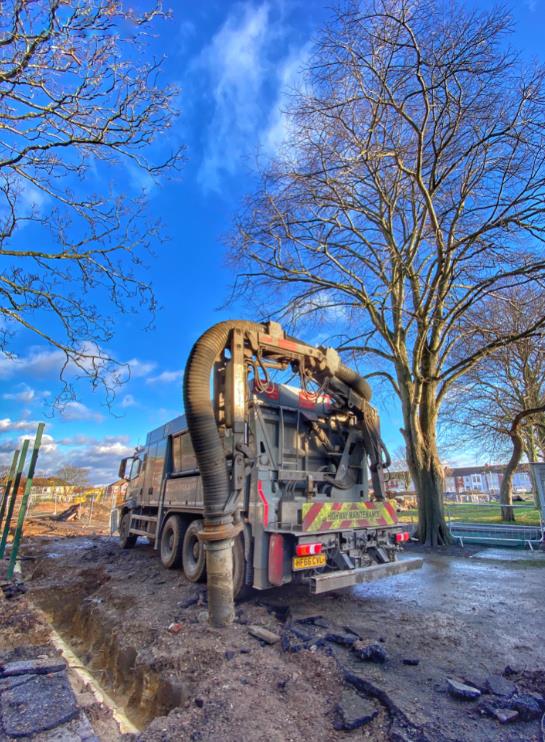The Problem
Since 1921, Mayfield School in Portsmouth has provided all through education (age 4 to 16) for 1,420 pupils across it’s 2.8Ha site. The current building is no longer safe or suitable, necessitating a full site redevelopment. The school had been subject to limited specific site investigations over the years; however, these had identified the presence of asbestos containing materials (ACMs) posing a risk to human health. The impacted soils had not been accurately delineated and presented a fatal risk to the deliverability and financial viability of the project. So much so that previously appointed contractors could not meet target budgets due to ground risk uncertainties. The challenge fell to Sanctus to design a remediation strategy that would provide absolute cost certainty, achieve immediate regulatory support and deliver significant cost efficiencies all against an incredibly tight timescale. Sanctus embraced the exact values that will be so prominent in the future of the school by working from base principles of science, technology, engineering and maths by solving the biggest challenges at project preparatory stage.

Background
The site currently comprises a central school building flanked by grassed playing fields to the east, largely residential area to the west, and is overlooked by attractive Georgian properties on all sides. The solution would see the New Mayfield School build on the existing playing field whilst the old school continues to operate. Upon occupation of the new building, the old school would be demolished, the site cleared and playing fields reinstated. The New Mayfield school will be one of the first schools in the country with dedicated Innovation Laboratory for Science, Technology, Engineering, Arts, and Mathematics (STEAM) in which pupils will problem solve and create the products of the future. Sanctus were awarded the contract to remove ground risk from the project, initially by conducting the site investigation across the eastern playing field. Our approach allowed for all material to be characterised before breaking ground for remediation.
Technical Challenges and Solutions
There were several challenges that Sanctus addressed, showcasing precision planning, smart engineering and surgical level accuracy in characterisation and contracting.
Design of Investigation
Sanctus undertook a data gap assessment exercise to determine the requirements for the investigation producing a preliminary conceptual model. The protection of the construction workers, residents, pupils and school staff were paramount throughout our design and delivery. Sanctus designed an extensive intrusive investigation which would remove the guesswork on the presence/absence of contamination and limit the contractual uncertainties. It was crucial to prove the vertical-lateral extents of impacted Made Ground relative to site level, which would provide the basis for calculating volumes of material requiring remediation. This investigation had to be delivered in an incredibly tight 2-week window, working around the academic calendar to minimise disruption to the school and its community. Securing investment at project preparation stage is often challenging but in this case was fundamental to delivering significant savings during contracting and making the entire project a viable option.

Precision Planning
Sanctus developed a 5m x 5m grid investigation providing coverage to the entire eastern playing field (the site of proposed development) with 400 exploratory locations providing 784 individual samples. This would result in a high-resolution sampling density of approximately 1 sample per 8.5m3 of material to be remediated. Each individual sampling location was set-out with GPS Survey Equipment and scanned with a Cable Avoidance Tool and Signal Generator, (along with vacuum excavation and controlled service trenches when work began). This grid and rigorous spatial data collection allowed accurate site levels on the stratigraphy, and importantly precise sampling areas and predetermined volumes to indicate/ delineate contaminated zones.
Implementation of Controls
All investigatory works were undertaken with full asbestos control measures in place, in a mobile segregated respirator zone. All works were undertaken in accordance with the Sanctus 3 Year Unconditional License to undertake works with Asbestos, as issued by the HSE, underpinned by standard operating procedures that form an integral part of the License. Minimising dust generation during the hot summer heatwave (in which the UKs highest ever temperature was recorded) was also a key objective. Sanctus employed a mobile point source suppression system capable of targeting specific work tasks without using unnecessary water. Proprietary moto fog MFJ10-MINI units were used for localised dust suppression in combination with manual knapsack sprayer style units for discrete locations. Sanctus staff and approved supply chain machine operators (embracing our principles of supporting local plant and labour where possible) utilised full Personal Protective Equipment and Respiratory Protective Equipment including Category 3 (BlueType) 5/6 particle tight coveralls and orinasal respirators (BS-EN-140) during investigation works. Sanctus organised and oversaw the training and upskilling of local operators and supply chain through their involvement in our works. The site boundary was secured with Heras style fencing, and hazard warning signage displayed. The working area was accessible exclusively through a Sanctus designed and approved mobile decontamination unit to prevent unauthorised access.
Near Source, Far Source (boundary) and Compliance personal air monitoring was conducted throughout the project by an independent UKAS accredited analytical contractor with Monitoring locations dependent on the site operations being conducted, as well as the prevailing weather conditions at the time of the monitoring. No exceedances of the asbestos control limit were identified by any of the monitoring completed.

Smart Engineering
One of the most challenging aspects of this project was the incredibly tight programme for delivery. To accelerate the investigation and recovery time lost prior to Sanctus’s appointment, two experienced environmental engineering teams were mobilised on site sequentially to ensure each had clear space to work at full capacity. The site investigation ultimately comprised 388 trial pits and 12 window sample boreholes. To address outstanding data gaps, hardstandings were investigated using windowless sampling methods and rapid reinstatement to maintain usage as access routes and carparks.
Protection of Nature / Trees
There were several Tree Preservation Orders where mechanical excavation was not permitted to prevent damage to the existing trees root systems. To avoid blind spots/data gaps and to mitigate potential damage to the tree roots, Sanctus utilised hand tools and modified vacuum extraction methods to investigate these areas (maintaining asbestos mitigation measures). Sanctus are unique in having developed proprietary methods and approach for the use of vacuum excavation in asbestos impacted soils. This ensured these iconic mature trees could be retained within the overall school redevelopment design whilst allowing remediation design of capping systems specific to those tree areas necessary to reduce legacy exposure.

Unexploded Ordinance (UXO) & Military Legacies
The site was in a high risk UXO area with several known Luftwaffe targets and confirmed impacts within 500m. Sanctus staff are trained in UXO awareness and had procedures in place when two UXO were encountered. The affected investigation locations were immediately suspended and fenced to prevent access. Sanctus arranged for ordnance disposal experts to remove the encountered UXOs. The first item was a graphite rod, used to target power systems and was not at risk of detonation. The second was unspent cartridge that was stable enough to be removed and disposed of offsite by specialists. Added to this 7 previously unknown air raid shelters were discovered and exposed at a variety of depths up to 0.8mbgl. The location of these were logged and mapped prior to remedial works.
Analysis
By focusing on gap filling and increasing the resolution of data points, building on the existing knowledge base, Sanctus successfully developed a robust remediation strategy and avoided any unnecessary costs for the client. This allowed a high definition asbestos distribution plan to be developed. When combined with waste characterisation and classification assessment this achieved a site wide delineation of <5m cells informed by assessing 2,291 individual results. Waste characterisation and assessment was then possible for each cell in advance of remedial works – this successfully provided programme, cost and material movement certainties and savings as well as accurate volumes for disposal.
Asbestos Containing Materials
A variety of ACMs were observed across the site during the investigation. The high density and robust sampling practice also aided in identifying limited localised areas of metal and polyaromatic hydrocarbon contamination. This enabled specific cells to be delineated and pre-classified for disposal, with only limited visual and verification testing required.
Additional Benefits
This density of sampling increased our understanding of the site and helped identify key relic and live services which were not detected by the previous contractors or investigations. These included various land drains, an unregistered 200mm gas service and 90mm potable water supply. These finds were included within the remediation strategy and importantly shared with the client and local education authority to again ensure unintended obstructions didn’t risk the delivery of the programme.
High Resolution Site Characterisation (HRSC)
Using this method of High-Resolution Site Characterisation (HRSC) techniques clearly had extensive benefits through preparatory work and successfully informed the development of a comprehensive data set, creating a robust CSM.
Regulatory Approval in Record Time
The application of HRSC techniques provided confidence and certainty of remediation techniques, enabling the approval of the remediation strategy by Portsmouth Council within two weeks of submission, an incredible turnaround time. This work far exceeded the requirements for sampling density for detailed investigation as recommended in BS 10175:2011+A2:2017, resulting in a safe more cost-efficient site. In addition to the Asbestos Controls and deployed license, regular audits were completed by the Sanctus HSEQ Manager as works proceeded, ensuring compliance with regulations and statuary articles. These were augmented by the clients HSEQ personnel.
Public / Stakeholder Engagement
Sanctus take pride in our commitment to public engagement. Sanctus held Public Consultation events based at the school over a series of dates for stakeholders and the public. A letter drop was distributed to all local residents so all members of the community were informed of the works. Sanctus operated an open-door policy, with interested members of the public who were able to visit the site office, being walked through operating procedures and environmental protection measures in place.
Economic, Environmental and Social Benefit
For many projects, off-site disposal of material represents a significant proportion of costs and environmental impact, both through end point disposal and transport. Using the HRSC Sanctus were able to take a surgical approach to contracting, minimising excavation volumes reducing costs and environmental impact. The remediation strategy successfully severed potential pollutant linkages which previously posed a risk to human health. Contractors in the groundworks / construction phase benefited from our proactive approach to site investigation by providing a better understanding of ground conditions, appropriate controls and minimising exposure to contamination materials. The local community also benefited by significantly minimising vehicle movements, which would have had significant impact on the local road network, and posed an increased risk to the health, safety and wellbeing of children and parents and adversely impacted air quality.
Conclusion
The rapidly undertaken high-resolution site characterisation enabled a very detailed and comprehensive remediation strategy to be formed based on a sampling density of one sample for <8.5m of material to be remediated. This strategy was reviewed and accepted by the local authority with no changes within 2 weeks, allowing remediation to begin during the end of term break.
